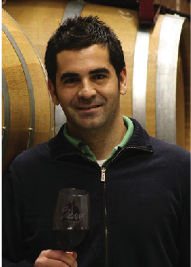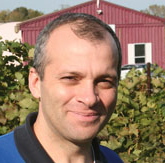Cabernet Franc can be a very versatile grape to grow in your backyard vineyard — and more forgiving in some ways than Cabernet Sauvignon. But what does it take to make good Cab Franc at home? In this issue, three experts discuss techniques for making Cabernet Franc in the vineyard and in the winery.
 Terry Neuner, Head Winemaker at Westphalia Vineyards in Westphalia, Missouri. Terry earned a Master’s degree in Biochemistry from the University of Missouri-Columbia and worked for several years researching fermentation and ethanol for the Missouri Farmers Association. He now brings his science background to his career as a winemaker.
Terry Neuner, Head Winemaker at Westphalia Vineyards in Westphalia, Missouri. Terry earned a Master’s degree in Biochemistry from the University of Missouri-Columbia and worked for several years researching fermentation and ethanol for the Missouri Farmers Association. He now brings his science background to his career as a winemaker.
One of the most important parts of our Cabernet Franc winemaking process is extended maceration. We always start with a cool grape, cooled to about 40 °F (4 °C). Then we de-stem the grapes and let them macerate off the stems for probably ten days. Our goal is avoiding all the fermentation to occur in the open air. It can be done in as little as eight days, but the average is ten.
When the must is about 60 percent fermented, we finish the fermentation in barrels. When making Cabernet Franc, it is oak only for this part of fermentation and then for aging. We use American white oak from right here in Missouri. Through this process, we do not have to employ any other techniques or add any other enzymes for color. That is why our extended maceration time helps — we do not have to do anything extra to bring out the color.
We ferment with a commercial yeast strain that is intended for use on Cabernet Franc. We certainly pay attention to acid, but we typically never have a pH that is too low; we only have to add tartaric acid. There are not too many other problems usually when making the wine. Overall it’s an easy grape to work with.
We make a single varietal Cab Franc, however, one of the reasons we make it is that it is a good blending wine. For example we also make a Norton and Cabernet Franc blend called Prodigal Son, which is very popular.
 Daniel Pambianchi is the former President and General Manager of Maleta Estate Winery and Cadenza Wines Inc. in Niagara-on-the-Lake, Ontario. He is the author of Techniques in Home Winemaking: The Comprehensive Guide to Making Château-Style Wines (Véhicule Press) and was also the former Technical Editor of WineMaker Magazine.
Daniel Pambianchi is the former President and General Manager of Maleta Estate Winery and Cadenza Wines Inc. in Niagara-on-the-Lake, Ontario. He is the author of Techniques in Home Winemaking: The Comprehensive Guide to Making Château-Style Wines (Véhicule Press) and was also the former Technical Editor of WineMaker Magazine.
Cabernet Franc tends to be light-colored, especially when grown in a cool-climate region like the Niagara Peninsula (where I make wine) and even moreso when harvested in a lesser vintage, and therefore could use anthocyanin-extraction techniques such as thermovinification or cold soak pre-ferment maceration. On a commercial scale, these treatments require special equipment that I, as a very small producer, do not have. So instead we go straight to fermentation at slightly higher temperatures to hasten color extraction and with the aid of enzymes. The grape also has less tannin than, for example, Cabernet Sauvignon, making that a concern in light vintages.
For yeast, Lallemand’s BM4X4 seems to work well for us because it seems to reduce vegetal characteristics that are so typical of this grape — and particularly in a light or poor vintage.
The type of oak you use with Cabernet Franc is more a choice of style and personal preference as a winemaker than anything else. We like to age part of the wine in French oak barrels and part in American oak barrels and then blend the wines just before bottling.
The challenges with this grape are with color, tannin and vegetal character (due to methoxypyrazines). High acid can be a problem in poor vintages, but nothing that a good malolactic fermentation (MLF) cannot fix. So for color extraction, lots of effective punch-downs are a requirement.
The decision to blend, too, is again a matter of personal choice and style. I personally prefer a Bordeaux style blend, i.e. a Meritage, and therefore always blend Cabernet Franc with Cabernet Sauvignon and Merlot. But I also make a 100% Cabernet Franc Icewine that is just delicious!

David Pagán Castaño, Head Winemaker at Breaux Vineyards in Purcellville, Virginia. David comes from a family of winemakers. Earning his Masters degree in Enology & Viticulture from Polytechnic University of Valencia in Spain, where David’s first professional winemaking job was at the family winery, Bodegas Castaño. Since then, he has studied wine all over the world.
When Breaux Vineyards first started, the owner wanted to try many different varieties, so we actually planted 60 different varieties although we are a relatively small vineyard and winery. Cabernet Franc was brought along with other varieties, but the difference with Cabernet Franc is that no matter what the year is, it always grows well. Year after year we get great harvests. We grow 4.8 acres total of Cab Franc. I think the vine spacing is 3.5 ft.
There are some common problems we encounter with growing Cabernet Franc, however. It is a very vigorous plant, and here, especially during the spring, we have sunny days and also lots of rain. This enhances the growth and vigor of the plant, causing it to just grow and grow. Because of that, we have to do both pulling and hedging quite often, or we’d have trees instead of vines.
When training the vines, we use the Lyre system, also called the “U” system, for trellising. This system creates a U shape with the vines so it has kind of a double canopy exposure. Usually, with more traditional systems, you have one canopy. In this system, however, the plant is divided in two trunks so for each vine you have two lines of canopy. This is great for Cab Franc because you maximize and double up the sun exposure.
If you are trying to grow Cab Franc at home, it is a great grape to grow. It is resistant to fungus and diseases in general. It matures quickly and the cycles tend to be shorter so you tend to mature without problems you might encounter with cold weather in the early fall. You can pick it early.
It is also good in terms of character, flavor, and the spiciness you get out of it. All of this makes for very complex wines. Overall, Cab Franc is just a great grape because of its resistance and also its great flavor and character.
 Terry Neuner, Head Winemaker at Westphalia Vineyards in Westphalia, Missouri. Terry earned a Master’s degree in Biochemistry from the University of Missouri-Columbia and worked for several years researching fermentation and ethanol for the Missouri Farmers Association. He now brings his science background to his career as a winemaker.
Terry Neuner, Head Winemaker at Westphalia Vineyards in Westphalia, Missouri. Terry earned a Master’s degree in Biochemistry from the University of Missouri-Columbia and worked for several years researching fermentation and ethanol for the Missouri Farmers Association. He now brings his science background to his career as a winemaker. Daniel Pambianchi is the former President and General Manager of Maleta Estate Winery and Cadenza Wines Inc. in Niagara-on-the-Lake, Ontario. He is the author of Techniques in Home Winemaking: The Comprehensive Guide to Making Château-Style Wines (Véhicule Press) and was also the former Technical Editor of WineMaker Magazine.
Daniel Pambianchi is the former President and General Manager of Maleta Estate Winery and Cadenza Wines Inc. in Niagara-on-the-Lake, Ontario. He is the author of Techniques in Home Winemaking: The Comprehensive Guide to Making Château-Style Wines (Véhicule Press) and was also the former Technical Editor of WineMaker Magazine.

